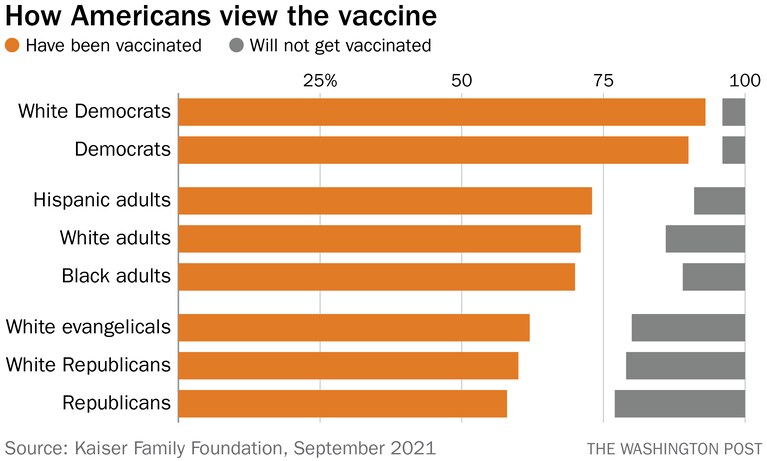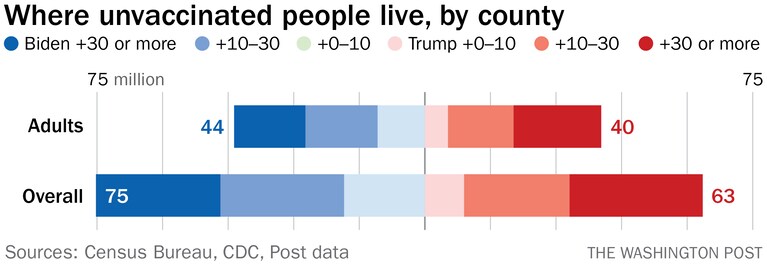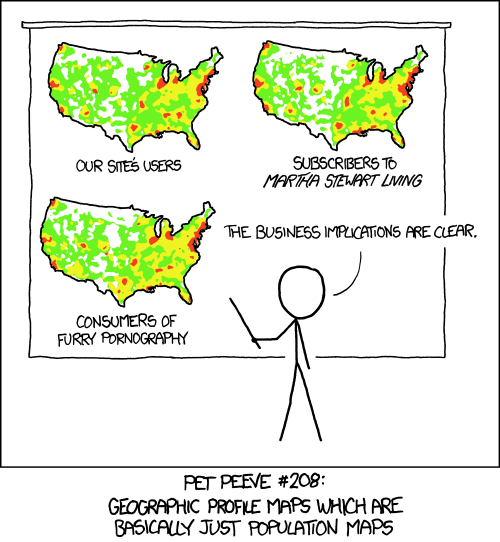More Unvaccinated People Live in Blue Counties
A paradox that's not hard to explain.
Via his Twitter feed, I saw Philip Bump’s report in WaPo headlined “Blue counties are more vaccinated — but still home to more unvaccinated people.”
The opener is not the least bit surprising:
Since late last year, there’s been a wide gulf between the willingness of Republicans and Democrats to be vaccinated against the coronavirus. That continues. In September, Kaiser Family Foundation polling found that Republicans were much more likely than Democrats to say that they intended to never receive a dose of a vaccine.

The headline gave away the plot twist:
And yet it also remains the case that there are more unvaccinated people in counties that voted for President Biden than ones that voted for former president Donald Trump.
Combining the most recent vaccination percentages from the Centers for Disease Control and Prevention with county-level population data from the Census Bureau, we see that there are about 4 million more adults in blue counties who are unvaccinated than in red counties. When expanding that to the entire population, the spread is 12 million people. (The distinction between all residents and all adults is important because of who is eligible for the vaccine.)

The explanation is exactly what I expected:
There are some obvious and important qualifiers here, of course. One is that there are a lot more people who live in blue counties than red ones. On average, 62 percent of adults in the most pro-Biden counties are vaccinated, compared to 41 percent of adults in the most pro-Trump ones. Another is that we don’t have full data; Texas, for one, doesn’t report vaccination rates by county. A third is that these figures don’t incorporate natural immunity acquired through having contracted the virus. That may limit the spread even in areas that have lower vaccination rates. And, finally, just because someone lives in a Biden-voting county doesn’t mean that they are a Democrat; about 45 percent of Trump voters live in counties that voted for Biden.
If we map out the areas where unvaccinated adults live, it’s mostly — but not entirely — a map of American population centers. You’ll notice, though, that there are also a number of red dots smattered across the map, often in places where there are no well-known large cities.
Which naturally reminds me of this old xkcd strip:







Thanks for calling out the BS here James.
I’m still baffled at the political strategy behind killing off your own supporters.
Good luck with that, I guess.
Our culture’s collective innumeracy risks becoming an existential threat.
Headlines are already one.
@Matt Bernius: But ‘twas always thus.
A Republican friend once told me global warming was due to dust from volcanoes. I asked him why he thought vulcanism had increased in recent decades. He didn’t understand the question.
Same question I ask Dr. T occasionally. Our existing political structures supported functioning democracy for two hundred years. (The early 1860s aside.) And the level of innumeracy in the populace has, if anything, decreased. What changed? My answers: money in politics and FOX “News”,
The dichotomous nature of red/blue continues to eat away at a lot of people’s brains:
Indeed.
Which is one of a ton of reasons why “if you do away with the EC, CA and NY will choose the president!” is such nonsense.
More on topic: partisan-based vaccine hesitancy ends up threatening the vaccinated’s health because “blue counties” are far from 100% blue.
@Steven L. Taylor:
Yes. I meant to make that point in the OP but got distracted by the math/heatmap issue.
@Tony W:
Republican politics (from the standpoint of the politicians, not the base), isn’t about winning. In fact losing would actually be better for them as it means they’re not responsible for actually accomplish anything, just for complaining about the Democrats not making everything perfect.
Red Bull, Elon Musk, and Matt Gaetz
There’s lots of money to be made off anti-vaxx Republicans, and if some of them die, the people earning that money care not, as long as enough remain to keep buying more. This is actually why they’re against the vaccine to begin with: it solves the problem permanently and it’s free, so there’s no cash stream available there. Fake cures that don’t work represent endless cashflow as there’s always a new fake cure that still doesn’t actually solve the problem and allows for a new new fake cure next month.
@Stormy Dragon:
As some as commented elsewhere, COVID19 is ironically more dangerous because its lethality is so low, because it makes it easy for some people to ignore the death toll in a way that wouldn’t work if it was something like Ebola with a 50% fatality rate.
@Steven L. Taylor:
Red counties get a double whammy of low vaccination rates and lowering or eliminating other mitigating measures, like the prohibition of mask mandates (like forbidding umbrellas in a rainstorm and expecting no one will get wet), capacity restrictions, etc.
I wish they’d all get the shots. I wish they’s kept mitigation measures. But if they think their lives aren’t worth the effort, I’m too tired and frustrated to talk them off the ledge.
@Kathy:
The most hilarious take is the anti-anti-anti-vaxxer Republicans, who are arguing that the Democrats only backed vaccines because we knew that would cause Republicans to reflexively refuse to take it and thus we’re actually responsible for all the Republicans committing suicide by COVID19.
Looked it up just this morn: Washington Co. MO – 30.2%
Yes, fully vaccinated and I still wear a mask everywhere I go.
@Stormy Dragon:
It’s the ultimate in personal responsibility: finding someone to blame for your stupid decisions.
@gVOR08:
BTW, we have only had full democracy since 1965. (And I think you are discounting a lot of problematic issues from the from, say, the 1870s to the 1960s to make your assertion).
@gVOR08:
Steven doesn’t mention it, but we have only had direct election of US Senators for roughly half that time. But that’s a minor quibble . . .
Even if we could analyze your question while holding the political system itself constant, the world isn’t the same. There are too many variables outside of design.
Disciplines are more more specialized and deeper.
The primary modes of political communication and news dissemination have changed at least three times.
And the specific issue of innumeracy is multifaceted:
Dealing with large numbers isn’t a natural ability of any animal.
Metrics as targets may (imo, likely) give an illusory sense of improved understanding. It’s plausible to me that test-taking skills have improved more than exam design, especially at scale.
At a surface level, it’s tempting to think math is somewhat resistant to shallow understanding. But math can be learned purely mechanically. Word problems can check against that, but my guess is very few, if any, educators test exclusively using those sorts of questions.
Recently, I thought back to the debate here surrounding the Reason op-ed critical of California’s proposed math curriculum. Perhaps someone mentioned it in one of those threads, but for whatever reason, I’ve become interested in the slide rule to the point of considering purchasing one.
As I’ve learned about it as a tool is that using it sharpens certain math skills like estimation as a quick means of error-detection in a way other computational tools don’t. But more than that, I’ve read in several places that simply learning how to use a slide rule deepens one’s understanding of how numbers relate to one another and a sharper picture of operations. James’s recent post about logarithmic charts comes to mind here.
@Kurtz:
It’s like the difference between a cook and a chef.
I’m reminded of the difference between the calc classes I (comp sci major) and my brother (accounting major) both took at college. He basically learned a bunch of “calc recipes” and if he ran into a problem that fit one of the “recipes” he knew, he could follow it and come up with an answer, but if you threw a problem at him that didn’t fit one of the “recipes” he memorized, there was nothing he could do about it. I got taught a lot more theory and was expected to be able to be thrown a novel situation and figure out how to come up with a new “recipe” that applied to it.